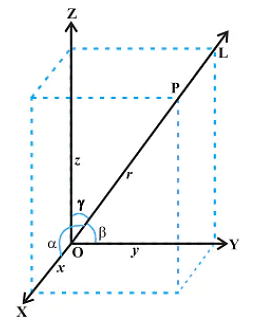If the shortest distance between the line joining the points \((1,2,3)\) and \((2,3,4)\), and the line \(\frac{x-1}{2}=\frac{y+1}{-1}=\frac{z-2}{0}\) is \(\alpha\), then \(28 \alpha^2\) is equal to
Correct Answer: 18
Approach Solution - 1
The shortest distance between two skew lines is:
\( d = \frac{|(\mathbf{b} - \mathbf{a}) \cdot (\mathbf{p} \times \mathbf{q})|}{|\mathbf{p} \times \mathbf{q}|}. \)
Here:
\( \mathbf{p} = \mathbf{i} + 2\mathbf{j} - 3\mathbf{k}, \quad \mathbf{q} = 2\mathbf{i} - \mathbf{j}, \quad \mathbf{a} = \mathbf{i} + 2\mathbf{j} + 3\mathbf{k}. \)
Calculate \(\mathbf{p} \times \mathbf{q}\), simplify \(d\), and compute:
\( \alpha = \frac{3}{\sqrt{14}}, \quad 28\alpha^2 = 18. \)
Approach Solution -2
The correct answer is 18.
\(\vec{r}=(\hat{i}+2\hat{j}+3\hat{k})+\lambda(\hat{i}+\hat{j}+\hat{k})\vec{r}=\vec{a}+\lambda \vec{p}\)
\(\vec{r}=(+\hat{i}-\hat{j}+2\hat{k})+\mu (2\hat{i}-\hat{j})\vec{r}=\vec{b}+\mu \vec{q}\)
\(\vec{p}\times\vec{q}=\begin{vmatrix} \hat{i} & \hat{j} & \hat{k}\\ 1& 1 & 1\\ 2& -1 & 0 \end{vmatrix}=\hat{i}+2\hat{j}-3\hat{k}\)
\(d=|\frac{(\vec{b}-\vec{a}).(\vec{p}\times\vec{q})}{|\vec{p}\times\vec{q}|}|\)
\(d=|\frac{(-3\hat{j}-\hat{k}).(\hat{i}+2\hat{j}-3\hat{k})}{\sqrt{14}}|\)
\(=|\frac{-6+3}{\sqrt{14}}|=\frac{3}{\sqrt{14}}\)
\(\alpha =\frac{3}{\sqrt{14}}\)
\(Now\, \, 28\alpha ^{2}=\not{28}^{2}\times\frac{9}{\not{14}}=18\)
Top Questions on Distance between Two Lines
- Find the shortest distance between the lines: \[ \frac{x - 1}{2} = \frac{y + 1}{3} = \frac{z}{4}, \quad \frac{x + 2}{1} = \frac{y - 3}{-2} = \frac{z + 1}{2} \]
- CBSE CLASS XII - 2025
- CBSE Compartment XII - 2025
- Mathematics
- Distance between Two Lines
- Let the line of the shortest distance between the lines \(L_1: \vec{r} = (\hat{i} + 2\hat{j} + 3\hat{k}) + \lambda(\hat{i} - \hat{j} + \hat{k})\)and \(L_2: \vec{r} = (4\hat{i} + 5\hat{j} + 6\hat{k}) + \mu(\hat{i} + \hat{j} - \hat{k})\) intersect \(L_1\) and \(L_2\) at \(P\) and \(Q\), respectively. If \((\alpha, \beta, \gamma)\) is the midpoint of the line segment \(PQ\), then \(2(\alpha + \beta + \gamma)\) is equal to \(\_\_\_\_\).
- JEE Main - 2024
- Mathematics
- Distance between Two Lines
- If the shortest distance between the lines \(\frac{x - \lambda}{-2} = \frac{y - 2}{1} = \frac{z - 1}{1}\) and \(\frac{x - \sqrt{3}}{1} = \frac{y - 1}{-2} = \frac{z - 2}{1}\) is 1, then the sum of all possible values of \( \lambda \) is:
- JEE Main - 2024
- Mathematics
- Distance between Two Lines
- If the shortest distance between the lines \[ \frac{x+2}{2} = \frac{y+3}{3} = \frac{z-5}{4} \quad \text{and} \quad \frac{x-3}{1} = \frac{y-2}{-3} = \frac{z+4}{2}\] is \(\frac{38}{3\sqrt{5}} k\) and \[\int_{0}^{k} \lfloor x^2 \rfloor dx = \alpha - \sqrt{\alpha}, \]where \([x]\) denotes the greatest integer function, then \( 6\alpha^3 \) is equal to _____
- JEE Main - 2024
- Mathematics
- Distance between Two Lines
- If the shortest distance between the lines.
L1: $\vec{r} = (2 + \lambda)\hat{i} + (1 - 3\lambda)\hat{j} + (3 + 4\lambda)\hat{k}$, $\lambda \in \mathbb{R}$.
L2: $\vec{r} = 2(1 + \mu)\hat{i} + 3(1 + \mu)\hat{j} + (5 + \mu)\hat{k}$, $\mu \in \mathbb{R}$ is $\frac{m}{\sqrt{n}}$, where gcd(m, n) = 1, then the value of m + n equals.- JEE Main - 2024
- Mathematics
- Distance between Two Lines
Questions Asked in JEE Main exam
- Match List-I with List-II.

- JEE Main - 2025
- Dimensional analysis
Nature of compounds TeO₂ and TeH₂ is___________ and ______________respectively.
- JEE Main - 2025
- Inorganic chemistry
- Let \( A = [a_{ij}] \) be a matrix of order 3 \(\times\) 3, with \(a_{ij} = (\sqrt{2})^{i+j}\). If the sum of all the elements in the third row of \( A^2 \) is \( \alpha + \beta\sqrt{2} \), where \(\alpha, \beta \in \mathbb{Z}\), then \(\alpha + \beta\) is equal to:
- JEE Main - 2025
- Matrices and Determinants
Consider the following sequence of reactions :

Molar mass of the product formed (A) is ______ g mol\(^{-1}\).- JEE Main - 2025
- Organic Chemistry
The magnitude of heat exchanged by a system for the given cyclic process ABC (as shown in the figure) is (in SI units):

- JEE Main - 2025
- Electric charges and fields
Concepts Used:
Three Dimensional Geometry
Mathematically, Geometry is one of the most important topics. The concepts of Geometry are derived w.r.t. the planes. So, Geometry is divided into three major categories based on its dimensions which are one-dimensional geometry, two-dimensional geometry, and three-dimensional geometry.
Direction Cosines and Direction Ratios of Line:
Consider a line L that is passing through the three-dimensional plane. Now, x,y and z are the axes of the plane and α,β, and γ are the three angles the line makes with these axes. These are commonly known as the direction angles of the plane. So, appropriately, we can say that cosα, cosβ, and cosγ are the direction cosines of the given line L.
